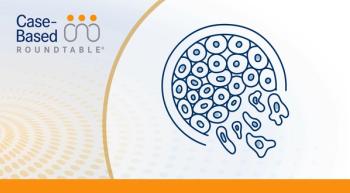
Case Presentation: A 63-Year-Old Woman with Relapsed-Refractory (R/R) Multiple Myeloma
Shaji Kumar, MD, presents a case of a 63-year-old woman with R/R multiple myeloma, shares his initial impression, and assess how clinical relapse impacts treatment decisions in patients with R/R multiple myeloma.
Episodes in this series

Transcript:
Shaji Kumar, MD: Hi, my name is Shaji Kumar. I’m a hematologist at Mayo Clinic in Rochester, Minnesota. Thank you for joining us today. I’m going to talk about a patient scenario first, then talk about the treatment choices we made, and then go into a discussion regarding the rationale and how to manage this patient on that specific therapy.
The patient we have is a 63-year-old woman with a past medical history of hypertension, asthma, and a remote history of smoking, who presented to the clinic with back pain. At that time, testing was done. She was noted to be hypercalcemic, with a calcium of 12.3 mg/dL, and anemic, with a hemoglobin of 10.3—both of which were new compared with her baseline labs. She ended up getting an additional workup, including serum protein electrophoresis that demonstrated an M [monoclonal] spike of 1.4 g/dL. That was immunoglobulin G κmyeloma. The serum creatinine was 1.3 mg/dL. A bone marrow biopsy was performed and confirmed to be 20% to 30% chronic plasma cells, and the fluorescence in situ hybridization revealed translocation t4;14.
She was started on a combination of bortezomib, lenalidomide, and dexamethasone, which is the standard induction therapy for 4 cycles, followed by autologous stem cell transplant and lenalidomide maintenance following the stem cell transplant. She had a good duration of response for approximately 3 years on this therapy and subsequently progressed. After that time, she had several combinations, initially with daratumumab, pomalidomide, and dexamethasone subsequently with the carfilzomib-based combination. As her fourth line of therapy, she received a BCMA [B-cell maturation antigen]-targeted antibody-drug conjugate in the form of belantamab mafodotin.
Now she’s presenting with a relapsed disease, having gone through 4 prior lines of therapy, including a proteasome inhibitor, IMiD [immunomodulatory drug], an anti-CD38 monoclonal antibody, and most recently, an anti-BCMA antibody-drug conjugate. Based on the available therapies, you had a discussion with her and decided on treating her with teclistamab, which was recently approved for the management of patients with 4 prior lines of therapy. Now she’s started on this tip-up dosing of teclistamab. Typically, this drug has a starting dose of 0.06 mg/kg. Then 2 days later, you get an increased dose of 0.3 mg/kg, and 3 more days later, the patients will get the full dose of 1.5 mg/kg. These are all given subcutaneously.
When the patient becomes refractory to the 3 commonly used therapies, especially the anti-CD38 monoclonal antibody, the IMiD, and the proteasome inhibitor, we do have a good number of choices in terms of treatments we can apply. We have an XPO1 inhibitor, selinexor, that has been studied in combination with a variety of different standard-of-care drugs, and just in combination with dexamethasone. We have belantamab, a BCMA-targeted antibody-drug conjugate, which is active by itself, with a response rate of approximately 30% in this kind of patient. This patient has already received belantamab, so it’s no longer a choice. The other choices certainly include traditional chemotherapy combinations that may include alkylating agents and anthracyclines. Given the activity we have seen with teclistamab in the clinical trials and with its recent approval, that certainly becomes a logical choice for a patient like this, in terms of therapy.
It’s important for us to make sure the patient has a disease that is relapsing and requires therapy. It’s not uncommon, especially in the early relapses, to see a very slow increase in the M protein. It’s something we often refer to as biochemical relapse, which does not require an immediate institution of a new therapy for all patients. If it is not a high-risk disease and did not originally present with any high-risk characteristics, including neurological issues or renal failure, then it’s reasonable to consider following them very closely to see what the trend of increase in the biochemical parameters is.
If the M protein or the free light chain is increasing rapidly, with a doubling time of 3 months or less, it’s very reasonable to get started on therapy. Of course, patients who present with end organ damage in the form of recurrent CRAB [Carbapenem-resistant Acinetobacter baumannii] features, whether it be new lytic lesions, renal insufficiency, hypercalcemia, or anemia, they clearly need to be started on therapy irrespective of the degree of biochemical progression they might have.
Finally, there are patients who may present with extramedullary disease or other clinical characteristics outside of CRAB features, which also point toward the need for therapy. It’s a combination of things, both in terms of myeloma-specific blood parameters and other findings that might come from imaging studies, all of which can contribute to that decision-making process as to when to start therapy for these patients.
Transcript edited for clarity.








































